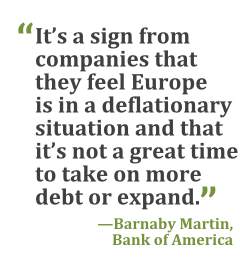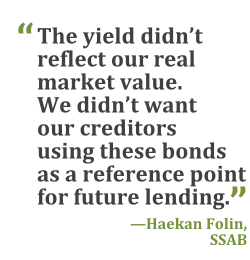For companies with enough cash on their books, there's a silver lining to the stormy credit markets: They can buy back their bonds on the cheap.
European companies including Anglo American Plc, Deutsche Bank AG, and Banco Comercial Portugues SA have agreed to buy back bonds at below their face value in recent weeks, generating instant profit and often reducing their indebtedness in the bargain. The transactions can be a way to show strength, an important statement to make in a market where investors are increasingly skeptical about the credit quality of many borrowers.
 So far this year, European companies bought back or announced tenders for 57 billion euros (US$62 billion), according to David Leeming, head of liability management for Royal Bank of Scotland Group Plc in London. That's more than five times the amount for the same period last year, said Leeming, who monitors buybacks from companies in Western Europe and Nordic nations in sterling, euros, and dollars.
So far this year, European companies bought back or announced tenders for 57 billion euros (US$62 billion), according to David Leeming, head of liability management for Royal Bank of Scotland Group Plc in London. That's more than five times the amount for the same period last year, said Leeming, who monitors buybacks from companies in Western Europe and Nordic nations in sterling, euros, and dollars.
More of these transactions are poised to happen in the coming months and years, a development that underscores the fragile state of European economies. Many companies in the region are awash in cash, and don't have enough confidence in their growth prospects to spend it on acquisitions, said Barnaby Martin, a European credit strategist at Bank of America Corp. Buying back debt is a way to instead reduce risk, a step that often makes sense when the profit outlook is less rosy.
“It's a sign from companies that they feel Europe is in a deflationary situation and that it's not a great time to take on more debt or expand,” Martin said.
There may be good reason for companies to have that fear. Consumer prices in the euro area fell 0.2 percent in February from the same month last year, according to a report on Monday. For three years inflation has fallen short of the European Central Bank's goal of nearly 2 percent. Economic growth in the area was just 1.5 percent in the fourth quarter compared with the same period a year earlier.
Buybacks Intended to Soothe Investors
In the case of Deutsche Bank, buybacks were partly meant to soothe investors concerned about its capital position. On February 12, the bank offered to buy back about $5.4 billion of bonds in dollars and euros in a series of transactions, after the company's shares and debt had plunged. On Monday, the bank said that in a recent round of buybacks, investors sought to sell only $740 million of dollar bonds to the bank, of the up to $2 billion it was willing to buy.
The lender said the low participation rate showed “improved market sentiment and an investor preference to retain exposure.” Deutsche Bank expects to book a 55 million-euro profit in its first-quarter results because of the buybacks, it said.
Debt buybacks typically make the most sense for companies with relatively high cash levels, and they're even better for borrowers with bonds that trade below face value. Still, it's not attractive for some long-term holders to sell their bonds back below where they bought them, said Jonathan Pitkanen, London-based head of investment-grade credit research at Columbia Threadneedle Investments, which manages about $200 billion in fixed income globally.
“Smart companies whose bonds are trading down often try to make the best of those circumstances,” said John Ericson, a New York-based partner in the corporate department at Simpson Thacher & Bartlett.
Companies repurchasing their notes are often junk rated, but may also be investment grade, as Deutsche Bank is. The transactions have tended to be more common in Europe, while in the United States, many companies with extra liquidity prefer to buy back shares or acquire competitors, Bank of America's Martin said.
 Last year, many liability buybacks were essentially refinancing transactions, where the borrower would issue new bonds maturing in a few years to pay off notes maturing in the near term. This year, as corporate bond prices fall, more issuers are buying back debt to book an accounting gain and reduce borrowings, said advisers at banks that help companies do these transactions.
Last year, many liability buybacks were essentially refinancing transactions, where the borrower would issue new bonds maturing in a few years to pay off notes maturing in the near term. This year, as corporate bond prices fall, more issuers are buying back debt to book an accounting gain and reduce borrowings, said advisers at banks that help companies do these transactions.
“When the market is softer, it creates a lot of inquiry from companies about buying back bonds,” said Graham Bahan, the London-based head of liability management for Europe, the Middle East, and Africa at Citigroup. “We're talking to a lot of companies about buybacks. I expect this will be a busy year.”
“Real Market Value”
These transactions are still relatively rare—the buybacks completed and announced this year make up less than 1 percent of the trillions of dollars of corporate debt in Western European and Nordic nations.
Anglo American said last week that bondholders sought to sell back $1.2 billion of notes denominated in euros and pounds, mostly below face value. The company took the measure after being cut to junk by the three major rating firms, which said that low commodity prices could hinder mine sales and debt reduction.
Swedish steelmaker SSAB AB chose to buy back bonds after Standard & Poor's downgraded the company deeper into junk territory last month. The yield on SSAB's euro-denominated bonds dropped to about 6.6 percent from around 9 percent following the offer to buy back up to 100 million euros of notes at a minimum of 94 cents on the euro.
“The yield didn't reflect our real market value,” Haekan Folin, chief financial officer at Stockholm-based SSAB, said. “We wanted to show we have the financial strength to do this. We didn't want our creditors using these bonds as a reference point for future lending.”
Companies outside of Europe are doing buybacks, too. Fortescue Metals Group Ltd, a Perth, Australia-based iron ore producer, said bond repurchases have helped it to slash interest costs and offset some of the pain created by the commodity price slump.
The average price on investment-grade corporate bonds worldwide fell to 103 percent of face value last month, while junk bonds dropped to 86 percent, both the lowest since September 2009, Bank of America Merrill Lynch index data show. Those kinds of price drops give more companies an incentive to buy back debt.
“These companies are trying to signal the strength of their liquidity position,” said Zoso Davies, a credit strategist at Barclays Plc in London. “They're putting their money where their mouth is.”
© 2025 ALM Global, LLC, All Rights Reserved. Request academic re-use from www.copyright.com. All other uses, submit a request to [email protected]. For more information visit Asset & Logo Licensing.




